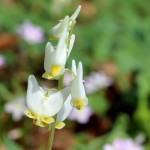
Dutchman’s Breeches, Dicentra cucullaria, starts flowering just a short while after the Bloodroot. It is also found growing on the rocky ledge in a rich organic layer from the oak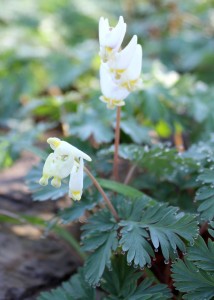 and hickory leaves. Dutchmen’s Breeches are very prolific spreaders. When conditions are to their liking they can form a wonderful blue green carpet sprinkled with unusual white flowers. It a native form of the cultivated Bleeding Heart.The Dogtooth Violet , Erythronium americanum, grows in large colonies consisting of hundreds of bulbs. These were found growing in a flood plain area along with the native Virginia Bluebell. and hickory leaves. Dutchmen’s Breeches are very prolific spreaders. When conditions are to their liking they can form a wonderful blue green carpet sprinkled with unusual white flowers. It a native form of the cultivated Bleeding Heart.The Dogtooth Violet , Erythronium americanum, grows in large colonies consisting of hundreds of bulbs. These were found growing in a flood plain area along with the native Virginia Bluebell. 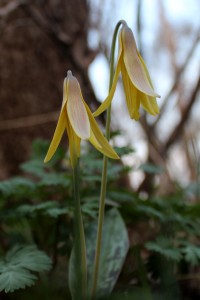 They flower at the same time as the Dutchman’s Breeches and just before the Bluebells come into peak flower.The foliage is also interesting and has curious dark speckles. These are also known as Trout Lilies since their leaves resemble the skin of a trout in appearance.While the plants appear in large colonies, there are never a lot of flowers blooming at one time and it is always a special surprise to find the nodding yellow flowers. Only the most mature bulbs produce flowers and they open sporadically. They flower at the same time as the Dutchman’s Breeches and just before the Bluebells come into peak flower.The foliage is also interesting and has curious dark speckles. These are also known as Trout Lilies since their leaves resemble the skin of a trout in appearance.While the plants appear in large colonies, there are never a lot of flowers blooming at one time and it is always a special surprise to find the nodding yellow flowers. Only the most mature bulbs produce flowers and they open sporadically.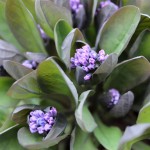
The Virginia Bluebells, Mertensia virginica, are perhaps one of the best known spring ephemerals in our Northern Virginia gardens.These exuberant ephemerals grow in lush clumps and remain ornamentally interesting for much longer than many of the ephemerals.Before the flowers open, their colorful flower buds look attractive nestled within the lush foliage.
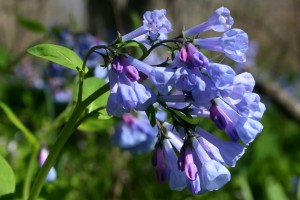 Where growing conditions are right, they grow in vast colonies in moist bottom land soils near streams. Where growing conditions are right, they grow in vast colonies in moist bottom land soils near streams.
If the spring weather stays cool, the flowering show can last for a month or more. It is quite an uplifting sight to see huge drifts of these bluebells in flower. Native white barked American Sycamore and the lemon yellow flowers of Spice Bush appear alongside these beauties and add to the scene.
While these plants thrive in rich flood plain soils, they also are adaptable to ordinary garden conditions. They are easily grown and reliable garden performers. Since they disappear into the ground by the end of May, one just needs to remember where they are planted so they aren’t accidentally dug up later in the season !
Where to see them
The Bull Run stream bed area is home to the largest stand of the Virginia Bluebell on the East Coast. There are a number of places along the stream where the bluebells grow in vast stretches. The Bull Run Regional Park is a great place to view them in person. The Stone Bridge Loop Trail in the Manassas Battlefield National Park is another great place to go to see the Bluebells and other fun sights of spring.
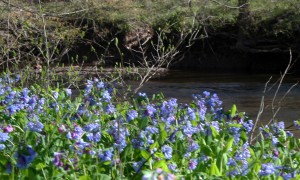
|